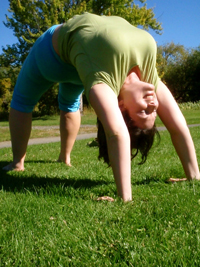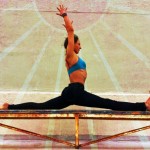by guest author Carol Lux, The Yoga Life
Next time you attempt Wheel Pose (back bend or Urdhva Dhanurasana) tell yourself;
“Lock Mula Bandha!”
You won’t believe the difference it will make.
Like magic your core will strengthen, your chest and pelvis will rise toward the ceiling and your arms will feel light and airy. I hear you asking;
“What miracle worker could this Mula Banhda be?”
Let me tell you a little story.
One day I found myself at an Ashtanga workshop and we were all attempting a drop back into a back bend.
Really? Just the thought of falling backward onto my head sent a chill up my spine and my throat constructed. Luckily, I had a very nice fellow student on one side and the Ashtanga Yoga mentor on the other. But still, what was I thinking attempting this?
Taking a deep, deep ujjayi breath, I went for it. My teacher said,
“Apply your Mula Bandha!”
Not wanting to take the effort to roll my eyes at him, I took him at his word and applied what I thought was mula bandha or root lock. I was still struggling and he could tell, so he attempted further elucidation;
“A Kegel contraction, contract Uranus!”
Thank Buddha they both were holding fast, as I almost collapsed.
“Contract Uranus?”
I giggled out. No that’s not what he had said. He actually was saying;
“Contract your anus.”
In Sankrit “mula” means root and “bandha” means lock or binding.
So when you hear, “apply mula bandha” or “apply your locks,” contract the muscles of your pelvic floor.
Women will recognize this as a Kegel exercise. It is more than just contracting your anus however. It means to contract the area of your root chakra. This is a technique for containing and channeling the energy associated with the mula-dhara (“root place”) chakra.
This chakra is generally located at the base of the spine, but inhabits your entire pelvic floor area. Muladhara chakra represents the stage of consciousness where basic survival needs dominate.
And believe me when you are upside down reaching for the floor, you definitely feel the need for survival skills.
So here’s what I did: I used that deep inhale for an ujjayi breath and gathered all of my energy and channeled it to my pelvic floor. You know those muscles you use to stop urinating in mid-stream? Yes, those muscles!
And yes this is just as true for men. I asked my male instructor how to relate this muscle contraction properly to another male. He said the muscles are the same ones used by men to stop the urination process in mid-stream, alternatively, a guy may want to think of contracting the muscles he uses to pull his testicles up into his body. Hope this helps guys!
With practice you can apply mula bandha to almost any asnana and create a much stronger pose while improving every aspect of your yoga practice. Let’s say you don’t want to be upside down reaching back for the floor before you finally get hold of your mula bahnda.
What asana can you practice prior to applying it in a pose such as Wheel?
Setu Bandha Sarvangasana (Bridge Pose). Yes – Bridge pose is the classic practice for mula bhanda. You may also recognize this pose as a pelvic thrust (And yes guys, this works just as well for you!)
- Lie on your back and bend your knees placing the soles of your feet on the floor, heels as close to the sit bones as possible.
- Exhaling press your feet and arms actively into the floor, lift your tailbone upwards, gently firming your gluts, lifting your buttocks off the floor. Keep your thighs and inner feet parallel.
- Clasp your hands below your pelvis and extend through the arms to help you stay on the tops of your shoulders.
- Lift your glutes bringing the thighs parallel to the floor. Keep your knees directly over the heels, pushing them forward and away from your hips. Lengthen the tailbone toward the backs of the knees.
- Extend your spine and lift your chin slightly away from the sternum. This helps to firm the shoulder blades against your back. Firm your outer arms, broadening your shoulder blades.
- Release with an exhalation, rolling the spine slowly down onto the floor.
- With each inhale upward apply your root lock, mula bandha holding the lock at the top. Exhale down. Rinse and repeat several times.
I bet you want to know if I was able to finish my drop back into Wheel Pose don’t you?
Well after giggling through the explanation of mula bandha and contracting Uranus – is that still a planet? Oh no it was Pluto that was demoted wasn’t it? – I was able to lock my root chakra and drop back into a full wheel (even at my age – ha ha still not telling you!)
I did not however, try standing back up. But do not fear! I will gather my root chakra power and try again soon. Oh yeah and let’s not forget what learning to control your mula bandha can do for your love life! I will let your imagination fill in the blanks here…
About Carol Lux
I came to yoga through athletics. After many years of collisions, contusions, concussions, sprains, strains and broken body parts I was gently guided toward yoga in my late twenties. I found that yoga soothed not only my body, but my mind.
I attribute my ability to continue playing and coaching into my 50s (dare I say it out loud?!) to my dedication to the yoga lifestyle. I love to write about yoga in all it’s various forms and incarnations with a quirky and humorous style.
Read more about how yoga can help athletes, seniors and everyone at my blog The Yoga Life.



Looks like you don’t know the difference between Moola Bhandha and Ashvini Mudra (…nor does your teacher). Also, these can be life threatening, if done incorrectly. The least you can do is not to teach these to the whole world until you master it yourself.
Hey HA,
I’m confused by your comment as it is Mula Bandha that the author is describing in this article. Perhaps you’re mistaken? Ashvini Mudra, or Ashwini Mudra is not done as part of other asanas as Mula Bandha is, but as a practice by itself using a seated posture. You can read more about Ashwini Mudra here.